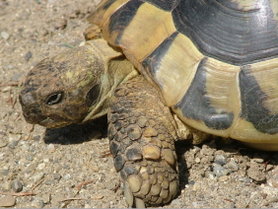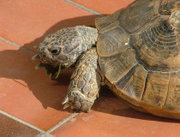Other Reptile Supplies
Reptiles are tetrapods, and also are amniotes, animals whose embryos are surrounded by an amniotic membrane. Today they are represented by four surviving orders: more...
- Crocodilia (crocodiles, Caimans and alligators): 23 species
- Rhynchocephalia (tuataras from New Zealand): 2 species
- Squamata (lizards, snakes and amphisbaenids ("worm-lizards") ): approximately 7,600 species
- Testudines (turtles): approximately 300 species
- Aves (birds): approximately 9,000 species, here categorized as a seperate class.
Reptiles are found on every continent except for Antarctica, although their main distribution comprises the tropics and subtropics. Though all cellular metabolism produces some heat, modern species of reptiles do not generate enough to maintain a constant body temperature and are thus referred to as "cold-blooded", though this term has fallen out of favor. (See the Leatherback Sea Turtle for an exception: a reptile that elevates its body temperature well above that of its surroundings.) Instead they rely on gathering and losing heat from the environment to regulate their internal temperature, e.g, by moving between sun and shade, or by preferential circulation — moving warmed blood into the body core, while pushing cool blood to the periphery. In their natural habitats, most species are adept at this, and can maintain core body temperatures within a fairly narrow range, comparable to that of mammals and birds, the two surviving groups of "warm-blooded" animals. While this lack of adequate internal heating imposes costs relative to temperature regulation through behavior, it also provides a large benefit by allowing reptiles to survive on much less food than comparably-sized mammals and birds, who burn much of their food for warmth. While warm-blooded animals move faster in general, an attacking lizard, snake or crocodile moves very quickly.
Most reptile species are oviparous (egg-laying). Many species of squamates, however, are capable of giving live birth. This is achieved, either through ovoviviparity (egg retention), or viviparity (babies born without use of calcified eggs). Many of the viviparous species feed their fetuses through various forms of placenta, just like mammals (Pianka & Vitt, 2003 pgs: 116-118). They often provide considerable initial care for their hatchlings.
However, note the taxonomy issues described below; mammals and birds can also be viewed as descendants of reptiles.
Classification of reptiles
From the classical standpoint, reptiles included all the amniotes except birds and mammals. Thus reptiles were defined as the set of animals that includes crocodiles, alligators, tuatara, lizards, snakes, amphisbaenians and turtles, grouped together as the class Reptilia (Latin repere, "to creep"). This is still the usual definition of the term.
Read more at Wikipedia.org


